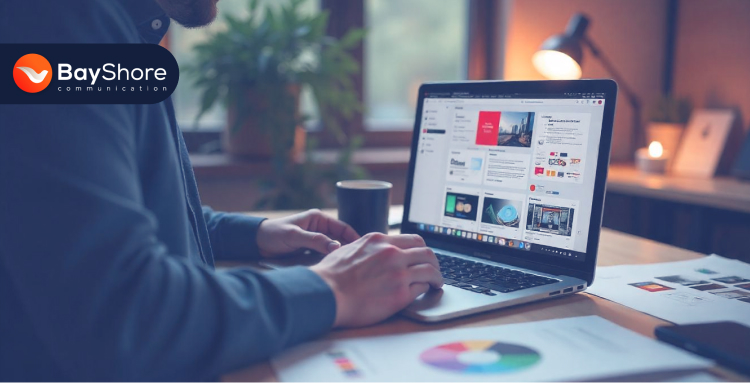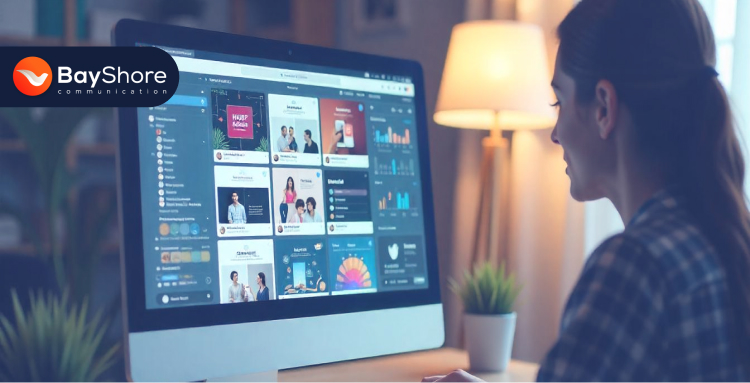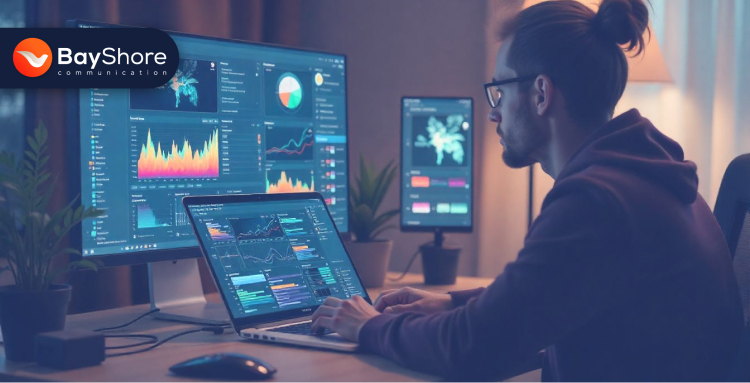
People process visuals 60,000 times faster than text. That means in the time it takes someone to blink, your image can hit them harder than a whole paragraph ever could. In a world where folks scroll past hundreds of posts a day, that speed isn’t just cool—it’s everything. It’s the difference between someone stopping to check out your stuff or just swiping by without a second thought.
Why’s this a big deal? Because in 2025, digital success is about grabbing attention fast and holding it tight. With attention spans dipping to like 8 seconds (less than a goldfish, seriously), visuals are your secret tactics to stand out. Let’s walk you through the best practices to make your visuals outstanding.
You can’t create impactful visuals if you don’t know who you’re creating them for. It’s like throwing darts in the dark—you might hit something, however, chances are, you’ll miss. Many top marketing sites mention audience research, but they barely scratch the surface. Let’s go deeper.
How to Get Inside Your Audience’s Head
Instead of guessing what your audience likes, use data to find out:
Google Analytics & Social Media Insights – Track who’s engaging with your content. Age, location, device type—it all matters.
X (formerly Twitter) & Instagram Polls – Quick and dirty way to test visual preferences. Post two image styles, and ask “Which one do you love?” Boom—instant feedback.
Heatmaps (Crazy Egg, Hotjar) – Want to know which part of your visual people focus on the most? Heatmaps show where users’ eyes (and clicks) go.
Also read: Why You Should Maintain Social Media Content Calendar for Your Business
Visual Personas
Every audience has a distinct visual language that resonates with them. Your job? Learn it and speak it fluently.
Gen Z – Loves bold colors, meme aesthetics, and casual, unfiltered content. Think BeReal vibes.
Millennials – Gravitate toward clean, aesthetic, slightly nostalgic visuals. Soft gradients? Yes, please.
Corporate Professionals – Appreciate polished, minimalistic designs with clear messaging. No fluff, just impact.
The more aligned your visuals are with your audience’s style, the more they’ll engage. Do a 5-minute hack to nail your audience’s visual taste. Run a poll on X or Instagram Stories. Show two different visual styles and ask, “Which one speaks to you?” It’s quick, free, and gives you real-time insights straight from your audience.

You’ve probably heard the usual design advice: “Keep it simple.” “Use good colors.” “Make it readable.” However, if you really want visuals that stop the scroll and drive engagement, you need to dig deeper. Big sites like Canva and Hootsuite touch on these principles; however, let’s take it up a notch.
Contrast & Hierarchy: How to Make Your Visuals Grab Attention
Ever wonder why some visuals immediately catch your eye while others just… fade into the background? That’s because of contrast and hierarchy.
Contrast: High contrast (like dark text on a light background) makes content easier to read and more attention-grabbing. Want to highlight something? Increase contrast.
Hierarchy: Your eyes naturally follow a visual path. Use size, boldness, and spacing to control where people look first. Example:
BIG, BOLD HEADLINE (grabs attention).
Medium-sized subtext (keeps them engaged).
Small, detailed text (for those who want to dive deeper).
Emotional Triggers: Make Them Feel Something
People don’t just look at visuals—they feel them. If you tap into the right emotions, your content becomes memorable and persuasive.
Trust & Reliability → Blue tones (Used by banks, tech brands, and social platforms like Facebook).
Urgency & Excitement → Red accents (Think “SALE” signs, breaking news banners).
Optimism & Energy → Yellow tones (McDonald's, Snapchat).
Nostalgia & Comfort → Retro filters (Soft grain, muted tones—used by brands like Nike & Levi’s).
Another example for you: Duolingo’s viral social posts use bright green text, meme energy, and playful design—because they know their audience loves chaotic, fun visuals.
Micro-Animations: Small Moves, Big Impact
Static images are cool, however a little motion goes a long way—especially in 2025’s increasingly interactive web.
Pulsing CTA buttons → Can boost clicks by up to 20%
Subtle hover effects → Make your site feel dynamic without overwhelming users.
Handwritten or “shaky” text animations → Add personality (especially for Gen Z & meme culture).
Do you remember that viral X (Twitter) post with neon green text + shaky animation? It worked because:
The neon contrasted hard against the dark background.
The movement made it impossible to ignore.
It felt handmade and personal, which increased the relatability.

Most blogs give you the same tired advice: "Optimize for social media." Cool, however, what does that actually mean? Every platform has its own algorithmic preferences, user behaviors, and ideal formats. A killer LinkedIn post won’t necessarily work on Instagram, and a TikTok graphic might flop on X (formerly Twitter).
If you want to maximize reach and engagement, you need to customize your visuals for each platform in strategy.
X (Twitter): Snappy, High-Contrast Visuals Win
Ideal Size: 1200x675px (always landscape-friendly).
Key Strategy: Bold text overlays + 5-10 second loops for auto-play engagement.
Algorithm Hack: X prioritizes native images/videos over external links—upload directly for better reach.
Special tip for you: Tweets with memes, short GIFs, or high-contrast infographics get 3x more shares than plain text posts. A simple before-and-after comparison image with big, bold captions tends to go viral because it’s instantly digestible.
Instagram: Carousel Hacking for Dwell Time
Ideal Sizes: For feed, 1080x1350px (portrait format gets more engagement than landscape). If you go for stories & reels – 1080x1920px (vertical, full-screen).
Key Strategy: Use carousels to break down complex info—Instagram rewards posts that keep users swiping.
Split a long infographic into 10 slides (each revealing new info) to extend dwell time and boost reach. Instead of a single infographic, a step-by-step "how-to" guide split into 10 slides can increase saves and shares by 40%.
LinkedIn: Data-Driven Visuals Over Generic Stock Photos
Ideal Size: 1200x627px
Key Strategy: Charts & graphs > stock photos. LinkedIn’s professional audience engages more with data visualizations than with generic images.
Overlay key statistics on visuals—people are more likely to share a powerful data point than a random office pic. Instead of a boring “teamwork” stock image, post a simple bar graph showing a trend in your industry—it positions you as an expert and gets more engagement.
Trend Alert: AI-Generated Visuals (The Right Way to Use Them)
AI tools like Midjourney, DALL·E, and Runway are blowing up, however, here’s the challenge: AI visuals can feel robotic and generic. The trick is to mix AI efficiency with human creativity.
Use AI for: Rapid prototyping, background images, and concept visuals.
Avoid: Overly polished AI-generated faces (people can tell they’re fake).
Combine AI art with hand-drawn elements or text overlays to make it feel authentic and unique. A brand used AI to generate product mockups,and then added real-user photos to make the campaign feel personal. Result? 30% higher engagement than AI-only visuals.
Here’s one tip if you want to save time while still optimizing for multiple platforms. Create one design, then resize it automatically using a free tool like Photopea or Canva’s Magic Resize.
More for you: How Do I Boost My Brand Online Presence with Content Marketing?

People don’t just consume content—they connect with stories. That’s why an emotionally charged image can go viral while a fact-packed chart gets ignored. If you want your visuals to stick, you need to show, not just tell. Most marketers mention “storytelling,” however few actually explain how to execute it visually. Let’s fix that.
Turning Your Visual into a Story
Every great story follows the problem → struggle → solution arc. Your visuals should, too.
Before & After Images → Show transformation (e.g., a messy desk vs. an organized workspace).
Step-by-Step Graphics → Guide the viewer through a process (e.g., “How I grew my brand in 6 months”).
Contrast Emotions → Show frustration first, then relief (makes the “solution” feel stronger).
Multi-Frame Posts Build Suspense
One image is good. A series of images is better.
X (Twitter) Threads: Post a numbered sequence of images to guide viewers through a story.
Instagram Carousels: Instead of one infographic, break it into multiple slides to increase dwell time.
TikTok & Reels: A “reveal” at the end of a video makes people watch longer, boosting engagement.
Let me give you an example, a viral X thread showed a brand’s rebranding journey in 5 images—each one revealing a new phase. It kept users scrolling and engaged.
Show What People Feel
Do you know what gets more engagement than a sales chart? A photo of a happy customer holding a product. Why? Because emotions drive action.
A smiling child > A donation graph.
A frustrated user > A generic “bad UX” statistic.
A teary-eyed reaction > A press release about an award.
So, before jumping into Canva or Photoshop, grab a notebook and write down a 3-part story:
Setup: What’s the starting point? (Problem, challenge, or situation).
Conflict: What’s the struggle? (Tension, frustration, effort).
Resolution: What’s the transformation? (Solution, relief, success).
This simple trick forces you to think in stories, not just designs.

The design world moves fast. If you're still using the same tools from three years ago, you’re missing out on AI speed boosts, real-time team collaboration, and next-level analytics. Most blogs will tell you about Canva and Adobe, however, let’s go deeper—into the fresh, must-know tools shaping 2025.
AI Boosters: Work Smarter, Not Harder
Runway → AI-powered video editing, auto-removes backgrounds, and generates clips from text prompts.
DALL-E 3 → Generate unique, high-quality images in seconds (great for custom illustrations).
Khroma → AI-driven color palette generator—perfect for branding and theme consistency.
Pro-Level Tools Without the Price Tag
Photopea → A full-fledged Photoshop alternative—works in your browser, no installs needed.
CapCut → TikTok and Reels edit like a pro with free transitions, auto-captions, and effects.
Inkscape → Vector graphics on a budget—great for logo design and illustrations.
Analytics Add-Ons: See What Works (and What Flops)
Hotjar → See where people hover, click, and drop off on your website’s visuals.
Attention Insight → AI predicts how eye-catching your design is before you publish it.
Meta Business Suite → Real-time insights on which visuals perform best across Facebook & Instagram.
Collaboration Is the Future of Design
Figma → The ultimate team-based design tool—multiple people can edit at once.
Miro → Digital whiteboarding for brainstorming visual ideas together.
Descript → Video editing + transcription in one tool—edit your video by editing the text.
Once you’ve created your visuals, you need to measure how they’re doing, make adjustments, and then keep improving. Here’s how to stay ahead of the game.
Metrics That Matter
Instead, focus on things that show real engagement—like the engagement rate, click-throughs, and dwell time. These metrics give you a better idea of how your audience is interacting with your content.
Find Out What Works and What Doesn’t
Try testing a blue vs. a red call-to-action button (CTA) on your landing page, and track the results using UTM links to see which color grabs more clicks. The data will help you decide which direction to take.
How to Improve Your Visuals Fast
If your image isn’t converting, change something simple like the font style or size and repost it. Try to turn this around quickly—within 48 hours if possible—so you can gather data while the momentum is still fresh.
To wrap it all up, creating impactful visuals is more than just adding together some nice pictures. It’s about understanding your audience, following design principles that make your visuals pop, mastering platform-specific strategies, and telling a story that people connect with. But here’s the kicker: even once you’ve nailed that perfect visual, the work’s not done. Keep measuring, tweaking, and optimizing to make sure your content is always hitting the mark.
Now, if you’re thinking, “This sounds awesome, but where do I start?”—let me point you to Bayshore Communication. With our expert design and digital marketing services, we can help you create visuals that grab attention, drive engagement, and keep your audience coming back for more. Reach out to us today and let them help you elevate your content to new heights.